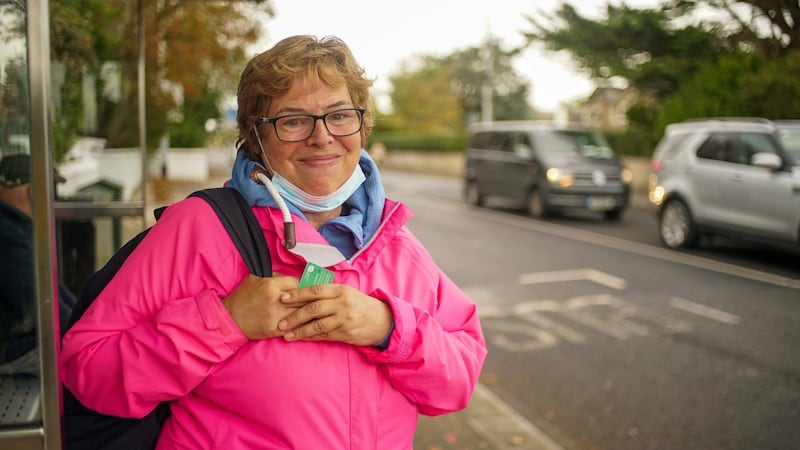On a crisp autumn morning in Fairview, north Dublin, shiny yellow and green buses pass in and out of the bustling village.
Commuters are running for the buses, which bear the new numbering system of H1, H2 and H3, while others are preoccupied at stops, scanning their phones to see when the next bus is due to arrive.
The H-spine was rolled out at the end of June and is part of the redesign of the bus network in Dublin under the €2 billion BusConnects project.
Following three rounds of public consultations, 72,000 submissions and dozens of local meetings, the first phase of the redesign has been implemented with few bumps in the road so far.
Fingal county councillor Eoghan O'Brien held three public meetings in Malahide, Portmarnock and Kinsealy during the consultation process, which attracted hundreds of people and was involved in others.
"I had never seen such a response to public meetings," the Fianna Fáil representative says. "It's been all quiet though on my end in terms of contact from the general public since the H-spine has been introduced so I would take that as a good sign.
“I saw a bit on social media when it first came in but it was to do with people who might not have been aware of the whole BusConnects process but I think it’s gone pretty well.
“Later drafts of the plans addressed the submissions that went in. It was a positive consultation process because areas were identified where certain routes were going to change to such a degree that they would have cut out large areas from their local bus route and the vast majority of concerns were addressed.”
Spine route
All of the H buses run from Lower Abbey Street down North Strand and through Fairview. There is a split at Raheny with H1 buses heading to Baldoyle, H2s serving Portmarnock and Malahide and H3s going to Sutton and Howth.

In addition, Howth has a city-bound route, the number 6, which takes the scenic route from Howth harbour, up to the summit and around Howth head, before meeting up with the H3 at Sutton Cross. The new routes replaced the old 29a, 31, 31a, 31b and 32 buses.
The H1 has a daytime frequency of 15 minutes while the H2 and H3 have a 30-minute frequency.
Standing at a bus stop in Fairview, student Lade Azineke says she takes the bus daily into the city centre, where she changes over to another bus to UCD.
“The buses are very good and always on time,” she says. “I’ve only just moved here so I hadn’t used the old service but the new numbering system seems okay.”
Also standing at the stop is Val Campion, who uses the bus every week to collect his pension.
“I know all of the Hs all go into the city centre. Going out of town, I think that’s where people struggle with it,” he says. “I’m not sure where the changeover is, where the Hs go after Fairview.”
Night-time buses
Further up the H-spine at a bus stop at Sutton Cross, carer Maureen Daly says the services are much better and there are extra buses at night time. "My partner is a chef so he gets his bus at 4.30am so it's really good," she says. "I actually think it's better because now you have the 6, H3, H2 and H1."
However, there are some who say they have not felt such benefits.
Ursula McLaughlin, from Howth, travels on the bus two or three times a week, usually to and from the city centre.
“I don’t understand the new bus system. Why they changed it to the H3, I don’t know,” she says. “We were quite happy with the 31. I went along to a meeting in the Marine Hotel in Sutton when they decided to change it all. They [the National Transport Authority] were telling us about this marvellous system but I can’t see anything that has improved.”
The aim of the redesign of the network as well as the other component of BusConnects, namely the creation of 230km of dedicated bus lanes in tandem with 200km of cycle tracks, is to increase the level of bus services in Dublin by 23 per cent and provide a more coherent service that will eliminate overlapping routes and improve journey times.
The lettering system from A to H identifies eight “spines” through the city, which will be complemented by 12 orbital routes (lettered O, N, S, W) and a number of local routes (L), city-bound routes (1-99), peak-only routes (P) and express routes (X).
Bus corridors
The National Transport Authority (NTA), which is overseeing the project, says improvements will come about as a result of the Core Bus Corridors element of the BusConnects programme, rather than the redesigned network.
“The benefits of the new network has always been about making the bus more useful to more people by improving frequency, service levels and connectivity,” says an NTA spokesman, adding that the rollout of the H-spine has “gone smoothly from an operational, communications and customer experience”.
Overall preliminary punctuality across the new routes is 78 per cent since commencement, compared with 70.9 per cent on the old routes between January and June 2021.
The C-spine, which will see buses running from Sandymount and Ringsend to Lucan and Kildare via the city centre is due to be rolled out from November 28th. The NTA says it is working towards "a similar outcome" for the spine.
Dr Brian Caulfield, associate professor in the Department of Civil, Structural and Environmental Engineering at Trinity College Dublin, says "massive travel time savings or anything like that" are not expected just yet.
"The change will happen when they start to put in the infrastructure, when they take out any of the pinch points and bottlenecks on the route. At the moment, I don't think Dublin Bus or the NTA did expect massive changes to happen with the changing of numbers.
“One of the things that it has done is that it’s consolidated routes... If you were new to the city, by having H1, H2, H3, it just makes it simpler. It makes it easier for people to follow and that’s the main logic behind these changes.”
Dr Caulfield adds it is “hard to know” what the impact of the new spine has been on car traffic due to the Covid-19 pandemic.
“There’s a huge proportion of people still working from home. There’s a huge proportion of people who are afraid to go on the bus and also a large number of cyclists and pedestrians who have come out as a result of the pandemic,” he says. “Whether they are taking people out of cars at the moment is very hard to know.”
Meanwhile, union sources say the H-spine is operating “reasonably well and it seems to be a relative success”.
“Drivers and passenger feedback through the drivers is that it has gone well,” the source said. “This was never going to fail, based on the big budget of BusConnects. This could not fail.”
Dr Páraic Carroll, assistant professor at UCD’s School of Civil Engineering, says “it’s great to hear there is positive feedback coming back from the commuters”.
“A lot of the spines that will be rolled out next will be based on what’s learned from the H-spine and actually maintaining the frequency is a challenge, ensuring there’s no road blocks or bottlenecks on these routes,” he says.















